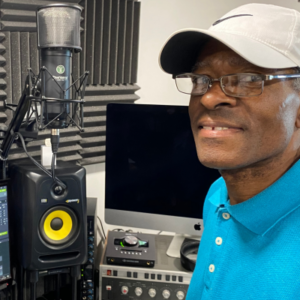When Sam Cooke joined the Highway QCs in 1945, he was fourteen years old. He had been singing Gospel in church since the age of six! In 1950, having become lead singer with the Highway QCs, Cooke moved on. He joined the Soul Stirrers, aged nineteen, and embarked on a career in Gospel music.
The Soul Stirrers were well-known and very popular, having built a reputation over the previous decade and a half. The group had made their first commercial recordings at Aladdin Records in Los Angeles in 1946. Songs such as “Lord, I’ve Tried”, written by Thomas A Dorsey, show the influence of Sister Rosetta Tharpe and Mahalia Jackson but also reveal the innovations that Rebert Harris, lead singer with the Soul Stirrers, brought to Gospel singing. He introduced the idea of falsetto parts and also suggested adding a second lead vocal, so that the quartet became a quintet of voices, with two singers sharing the lead and three singers adding backing vocals. The tightly controlled arrangements of earlier groups now became looser, with space for improvisation. New compositions, especially those of Thomas A Dorsey, were added to the repertoire of hymns and spirituals. The Soul Stirrers were able to tour throughout the United States during the post-war years, building a strong fan base. The emergence of recording opportunities with new independent labels in Los Angeles brought significant opportunities.

Aladdin issued sixteen Soul Stirrers’ Singles between 1946 and 1950, after which the group moved to Specialty Records. The new company issued four singles in 1950, including “By And By”, arranged by founder members Rebert Harris and Roy Crain. Towards the end of that year, however, Harris left, as a result of his disillusionment with the recording industry and the immorality of some of the people he met on the Gospel circuit. He was quickly replaced as lead vocalist by Paul Foster, who had taken over the second lead role in 1949. Roy Crain then recruited Sam Cooke, who was a great admirer of R.H. Harris, at the end of 1950. Although only nineteen, Cooke’s talent meant that he was soon promoted to the main lead vocal spot.

The first Soul Stirrers’ first release with Sam Cooke as lead vocalist was “Peace In The Valley”/ “Jesus Gave Me Water” in 1951. The A-side is a spiritual sung in a traditional style with a soulful lead vocal from Cooke that lifts the group’s performance to a new level. The B-side is a new song, written by Lucie E. Campbell. It is more up-tempo, with a dance beat. Cooke infuses the song with such a sense of joy that it is impossible not to respond. Seventy-one years later, “Jesus Gave Me Water” was chosen for inclusion in the National Recording Registry by the US Library of Congress.
Follow-up singles “Come Let’s Go Back To God” (1951) and “I’m Gonna To Build On That Shore” (1952) reinforce the impact of Cooke’s arrival on the Soul Stirrers. Cooke takes the innovations of R. H. Harris and adds real emotion to his solos, sliding into falsetto phrases that contrast with the more traditional approach of the alternate lead vocal, sung in a lower register. It is Cooke that adds the Soul and the power to these songs.
In 1954, Cooke’s arrangement of “Come And Go To That Land” demonstrates his desire to loosen the traditional patterns of the old spirituals and to bring an up-tempo bounce to the group’s songs that would attract the attention of people outside the church. In particular, his good looks and soulful voice appealed to young people. He had star quality!

Over the following two years, Specialty issued three more singles by the group, “Nearer To Thee”, “I’m So Glad” and “Wonderful”. “Nearer To Thee” is backed by “Be With Me Jesus”. Both tracks were written by Sam Cooke, which seems to have given him the confidence to take Harris’ innovations to new heights. The A-side introduces the yodel-like phrasing that was later to grace some of Cooke’s early secular hits. Both tracks have a bouncy sing-along, foot-tapping, hand-clapping rhythm and both have instrumental backing (organ and piano) instead of being sung a cappella.

“I’m So Glad” was written by founder-member (Silas) Roy Crain. It has a more traditional feel, driven by a rhythmic drum beat, but here too Cooke includes one Pop-style trill. Cooke’s vocal is supported by a strong response from the group. The B-side “One More River”, written by James Cleveland, is turned by Cooke into a Soul ballad, with many of the stylistic elements that later became his trademark.

The third of the Soul Stirrers’ singles from 1956 was “Wonderful”, backed by “Farther Along”. The tracks continue to show Sam Cooke pushing Gospel ever closer to secular styles of music. “Wonderful” is the final step on Cooke’s road to Pop music. The instrumental backing gets stronger, the backing vocals are smoother and more romantic, and above all Cooke is singing a love song.

Specialty issued one more Soul Stirrers’ song with Sam Cooke taking lead vocal in 1957. “Were You There”, arranged by Roy Crain, is another powerful expression of Sam Cooke’s mastery of his new approach to Gospel Soul. There is a raw edge to his voice that was rarely heard once he made the move to Keen Records and then RCA Victor. The B-side, “Sinner, Run To Jesus”, has Paul Foster on lead vocal. An interesting comparison!
In the Summer of 1957, Art Rupe (the owner of Specialty Records) gave the OK to Bumps Blackwell to take Sam Cooke down to New Orleans to work on some secular songs. Blackwell had worked in New Orleans with Little Richard in 1956, producing three major hits, “Long Tall Sally”, “Ready Teddy” and “Rip It Up”, which had brought Specialty Records to national attention. Art Rupe clearly hoped that he could the same with Sam Cooke.
One of the tracks that Cooke recorded at Cosimo Matassa’s studio in New Orleans was “Lovable”, a secularised version of “Wonderful” that Cooke had sung with the Soul Stirrers. It was issued by Specialty under the name Dale Cook, probably on the instructions of Rupe, who did not want Sam Cooke’s desire to sing solo secular material to undermine the popularity of the Soul Stirrers. “Lovable” didn’t make much impact in the Pop music market place, but Blackwell and Cooke wanted to continue the experiment. Rupe did not agree. He may well have been hoping that Sam Cooke could become a second Little Richard, so he was not impressed by romantic Pop ballads.
As a result of the ensuing dispute, Blackwell was sacked by Rupe and Sam Cooke left Specialty. Together, they found a new home at Keen Records.

A compilation of all the tracks recorded by The Soul Stirrers with Sam Cooke was issued by Specialty in 2002. It features multiple versions of several songs. The collection provides plenty of evidence that underlines the importance of this phase of Cooke’s career to his development as “the inventor of Soul”.

















